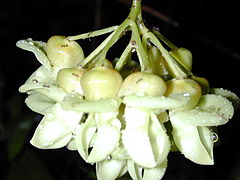Ukpo
| Mucuna | |
|---|---|
 |
|
| Mucuna gigantea flowers | |
| Scientific classification | |
| Kingdom: | Plantae |
| (unranked): | Angiosperms |
| (unranked): | Eudicots |
| (unranked): | Rosids |
| Order: | Fabales |
| Family: | Fabaceae |
| Subfamily: | Faboideae |
| Tribe: | Phaseoleae |
| Genus: |
Mucuna Adans. |
| Species | |
|
Some 100, see text. |
|
| Synonyms | |
|
|
Some 100, see text.
Mucuna is a genus of around 100 accepted species of climbing lianas (vines) and shrubs of the family Fabaceae and typically found in tropical woodlands.
The leaves are tripalmate, alternate, or spiraled, and the flowers are pea-like but larger, with distinctive curved petals, and occurring in racemes. Like other legumes, Mucuna plants bear pods. They are generally bat-pollinated and produce seeds that are buoyant sea-beans. These have a characteristic three-layered appearance, appearing like the eyes of a large mammal in some species and like a hamburger in others (most notably M. sloanei) and giving rise to common names like deer-eye beans, donkey-eye beans, ox-eye beans, or hamburger seed.
The name of the genus is derived from mucunã, a Tupi–Guarani word for these species.
The pods of some species are covered in coarse hairs that contain the proteolytic enzyme mucunain and cause itchy blisters when they come in contact with skin; specific epithets such as pruriens (Latin: "itching") or urens (Latinized Ancient Greek: "stinging like a nettle") refer to this. Other parts of the plant have medicinal properties. The plants are used in herbalism against a range of conditions, such as urinary tract, neurological and menstruation disorders, constipation, edema, fevers, tuberculosis, ulcers, Parkinson's disease, and helminthiases like elephantiasis.Velvet bean (M. pruriens) is one of the most important sources of L-dopa, a common component of nootropics ("smart drugs"); it also contains serotonin, 5-HTP, nicotine, and some decidedly psychoactive compounds (see below).
...
Wikipedia
